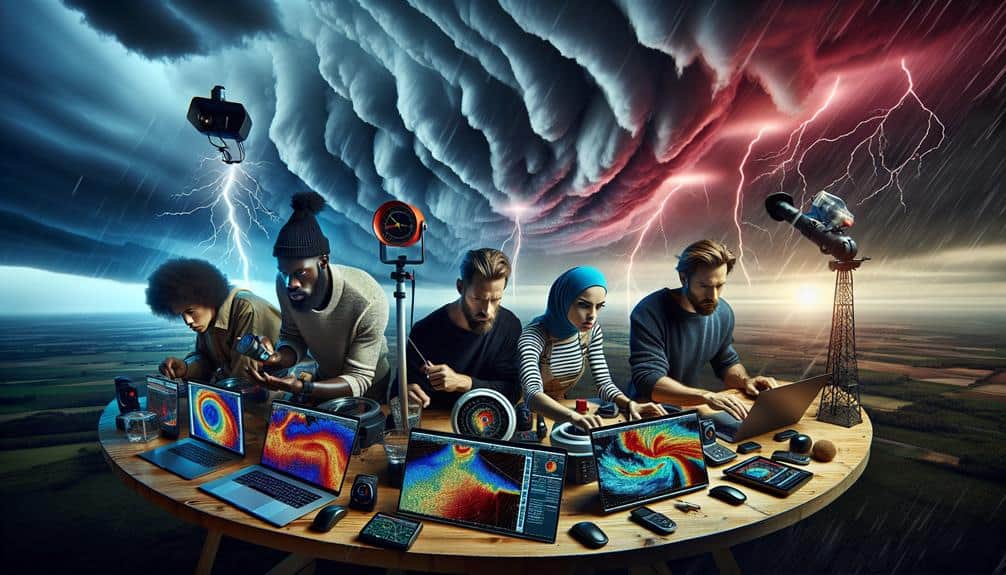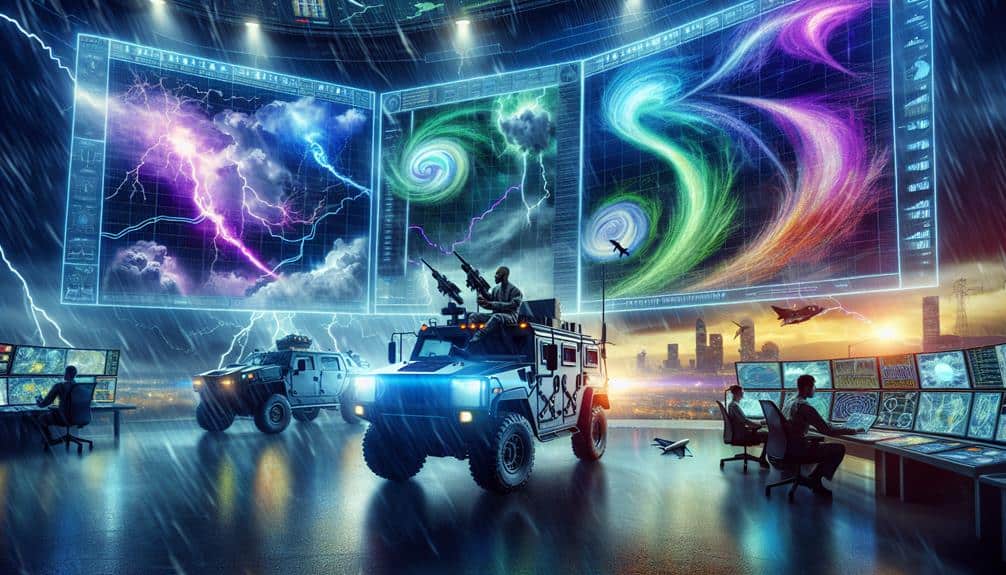We depend on advanced Doppler radar systems to measure storm speed and direction, using frequency shifts to capture wind velocity within storm systems. GPS navigation devices offer granular location data, greatly boosting prediction accuracy. Weather balloons provide vertical atmospheric profiles essential for data validation. Anemometers deliver real-time wind speed and direction readings. Portable weather stations capture essential meteorological data in remote areas, while high-definition cameras on drones and aircraft track storm behavior visually. Satellite communication equipment guarantees we transmit storm data in real-time, essential for timely warnings. Uncovering these tools' synergistic use will enrich your storm tracking knowledge.
Key Points
- Doppler radar systems measure storm speed and direction through frequency shifts, essential for early detection and forecasting.
- GPS navigation devices provide precise location data for accurate storm path prediction and emergency response planning.
- Weather balloons ascend to collect vertical profiles of atmospheric parameters, vital for accurate storm tracking.
- Anemometers offer real-time wind speed and direction data, crucial for predicting storm paths and intensities.
Doppler Radar Systems
Doppler radar systems enable us to precisely measure storm speed and direction by analyzing the frequency shift of returned radar signals. These systems emit a radar beam that travels through the atmosphere, encountering various weather patterns. As the beam interacts with precipitation particles, it reflects back to the radar, allowing us to determine the speed and movement of storms.
By examining the frequency shift in the returned signals, we can accurately measure wind velocity and direction within storm systems. This ability is vital for early storm detection, providing essential meteorological data that aids in forecasting severe weather events. With Doppler radar, we can pinpoint the location and intensity of storms, enabling us to issue timely warnings and take necessary precautions.
Our capacity to interpret these radar signals translates into actionable insights, such as identifying rotation within supercell thunderstorms that might develop into tornadoes. By integrating Doppler radar data with other meteorological data sources, we paint a detailed picture of evolving weather patterns. This empowers us to make informed decisions, ensuring our safety and enhancing our freedom to navigate the elements with confidence.
Let's now analyze how GPS navigation devices enhance storm tracking with real-time location accuracy and sophisticated weather integration capabilities.
These devices provide precise geospatial data, enabling us to monitor storm trajectories with high accuracy.
Integrating weather data into GPS systems allows for predictive modeling and timely updates, improving our ability to anticipate storm movements.
Real-Time Location Accuracy
Accurate storm tracking hinges on the precision of real-time GPS navigation devices, which provide granular location data critical for predicting storm paths. In our quest for superior storm prediction, technology advancements have empowered us to achieve unprecedented accuracy.
Modern GPS devices, boasting precision tracking capabilities, can pinpoint storm locations within meters. This level of accuracy isn't just theoretical; empirical data shows a significant reduction in error margins, enhancing our predictive models.
For emergency response teams, these advancements are game-changing. Precision tracking allows for swift, targeted responses, minimizing risk and maximizing safety. When a storm's trajectory is known with high precision, evacuation routes can be optimized, and resources can be allocated more effectively.
In real-time scenarios, every second counts, and our current technology guarantees we utilize each moment to its fullest potential.
Furthermore, integrating these GPS devices with other data sources, such as radar and satellite imagery, augments their effectiveness. We aren't just tracking storms; we're predicting their behavior with a high degree of confidence.
As we continue to refine this technology, our ability to forecast and respond to storm events will only improve, granting us greater freedom to protect lives and property.
Weather Integration Capabilities
Integrating weather data with GPS navigation devices allows us to combine a multi-faceted perspective of storm dynamics, enhancing predictive accuracy and response strategies. By integrating weather app functionality, we can seamlessly connect real-time meteorological information with advanced GPS systems. This fusion offers a detailed understanding of storm patterns, empowering us to make data-informed decisions.
Storm tracking software incorporated within GPS devices provides unmatched forecast accuracy. When a storm's trajectory is accurately forecasted, emergency response planning becomes more efficient. We can proactively allocate resources and plan evacuation routes, reducing the impact on affected populations. The capability to visualize storm paths alongside navigation data guarantees that our strategies are both proactive and effective.
Furthermore, the merging of weather data with GPS devices is a game-changer for individuals who prioritize independence and readiness. We can receive timely notifications and make informed choices without solely depending on external sources. The synergy between weather app integration and GPS technology not only enhances our situational awareness but also boosts our ability to navigate and respond to challenging weather conditions.
Essentially, this technological advancement provides us with the freedom to adapt quickly and confidently amidst nature's unpredictability.
Weather Balloons

Let's now focus on weather balloons, critical instruments in storm trajectory analysis.
We'll examine their data collection methods, which include measuring temperature, humidity, and atmospheric pressure at various altitudes.
Additionally, we'll assess their altitude capabilities and operational longevity, providing us with thorough atmospheric profiles essential for accurate storm tracking.
Data Collection Methods
Weather balloons serve as a critical tool in our arsenal for collecting atmospheric data and tracking storm trajectories. By ascending through various layers of the atmosphere, these balloons provide invaluable vertical profiles of temperature, humidity, and wind speed. This data is essential for enhancing the precision of our predictive models.
We complement weather balloons with drone surveillance and remote sensing technologies. Drones can penetrate regions that weather balloons might miss, offering high-resolution data and real-time updates. Remote sensing technologies, such as satellite imagery, provide a broader spatial context to the data gathered by weather balloons.
Combining these methods allows us to cross-verify information and refine our models further.
Ground truthing is another important aspect. By comparing the data collected from weather balloons with on-the-ground observations, we secure its accuracy. Citizen scientist contributions are invaluable in this regard. Enthusiastic individuals equipped with basic meteorological instruments can provide ground-level data, enriching our datasets and validating our findings.
Altitude and Longevity
To maximize the utility of weather balloons, we must understand their altitude capabilities and operational longevity in various atmospheric conditions. Knowing how high these balloons can ascend and how long they can remain operational is essential for accurate storm tracking.
First, let's break down their functionality:
- Altitude Capability: Weather balloons can reach heights of up to 35 kilometers (22 miles). This allows us to collect data from various atmospheric layers, aiding in precise modeling of flight patterns and wind speeds.
- Operational Longevity: Typically, these balloons have a lifespan of around 2 hours before they burst due to decreased atmospheric pressure. This window is crucial for capturing real-time data on atmospheric conditions and storm movement.
- Data Transmission: Equipped with radiosondes, weather balloons continuously transmit data on temperature, humidity, and pressure. This real-time information is essential for analyzing storm trajectories and making timely predictions.
Understanding these aspects helps us optimize the deployment of weather balloons, ensuring they provide the most accurate data possible.
Anemometers
Anemometers, which measure wind speed and direction with high precision, are essential tools for tracking storm trajectories accurately. By providing real-time data on wind speed and wind direction, anemometers help us predict storm paths and intensities with greater accuracy. These devices are often equipped with advanced sensors that capture minute fluctuations in wind patterns, allowing us to analyze the storm's evolving dynamics.
Anemometers come in several types, including cup, vane, and ultrasonic models, each offering unique benefits. Cup anemometers measure wind speed via rotating cups, while vane anemometers gauge wind direction with a tail fin. Ultrasonic anemometers, the most sophisticated of the three, use sound waves to determine both wind speed and direction, offering high-resolution data even in turbulent conditions.
Our ability to interpret this data enables us to make informed decisions about storm preparedness and response. For example, when an anemometer detects a sudden increase in wind speed, it signals a potential escalation in storm intensity. By continuously monitoring wind direction, we can also track changes in the storm's trajectory, allowing for timely evacuations or other safety measures.
Ultimately, anemometers empower us to safeguard our freedom by providing the critical information needed to navigate and respond to storm threats effectively.
Portable Weather Stations
Portable weather stations pack a full suite of meteorological instruments into a compact, mobile unit, enabling us to gather essential atmospheric data in remote or rapidly changing environments. These devices are indispensable for storm chasing and field research, providing real-time data that can enhance our understanding of weather patterns and improve safety measures.
In storm chasing, portable weather stations help us capture crucial parameters such as wind speed, temperature, humidity, and atmospheric pressure, all of which are vital for predicting a storm's trajectory and intensity. Their compact design allows for easy transportation and quick setup, making them ideal for dynamic and unpredictable field conditions.
Here are three key features of portable weather stations that make them necessary for our field research:
- Real-time Data Transmission: Enables instant access to essential weather data, allowing us to make timely decisions and adjustments.
- Multi-Sensor Integration: Combines various meteorological instruments into one unit, providing a thorough data set from a single location.
- Durability and Portability: Designed to withstand harsh weather conditions and rugged terrain, ensuring reliability and functionality in diverse environments.
High-Resolution Cameras
High-definition cameras allow us to capture detailed visual data of storm systems, providing invaluable information for tracking and analyzing storm behavior.
These cameras, equipped with advanced optics and sensors, can offer us a real-time, detailed view of cloud formations, precipitation patterns, and wind movements.
By integrating thermal imaging capabilities, we can detect temperature variations within storm cells, aiding in the identification of potential development zones and intensity changes.
Remote sensing technology enhances our ability to monitor storms from a distance, reducing the risk to human life while ensuring continuous data collection.
High-definition cameras mounted on drones and aircraft enable us to gather thorough visual data even in inaccessible areas.
The coupling of thermal imaging with high-definition optics allows for the detection of heat signatures, essential for understanding storm dynamics, such as updrafts and downdrafts, which are critical in storm intensification.
Satellite Communication Equipment

Leveraging satellite communication equipment, we can transmit vast amounts of storm data in real-time, guaranteeing that meteorologists have access to the latest information for accurate forecasting and timely warnings.
Satellite internet connectivity is essential. It enables continuous data transmission from remote monitoring stations, providing insights into storm trajectory changes and intensity. This technology is indispensable for disaster preparedness, allowing authorities to make informed decisions quickly.
Our satellite communication systems enhance emergency response capabilities. When terrestrial networks fail, satellite links remain operational, guaranteeing uninterrupted communication. This reliability is crucial for coordinating rescue operations and delivering timely updates to affected communities.
Here are three key benefits of using satellite communication equipment:
- Real-Time Data Transmission: Immediate access to up-to-date storm information helps meteorologists predict storm paths accurately, ultimately saving lives.
- Enhanced Remote Monitoring: Satellites provide comprehensive coverage, even in remote areas, ensuring no storm activity goes unnoticed.
- Robust Emergency Response: Satellite connectivity ensures that emergency services can communicate effectively, even when ground infrastructure is compromised.
Frequently Asked Questions
How Do Meteorologists Predict the Intensity of a Storm?
When Hurricane Katrina formed, we analyzed storm formation using predictive tools like satellite imagery and computer models. These tools help us predict intensity by tracking temperature, wind speed, and pressure changes, offering data-driven insights for timely decisions.
What Is the Role of Computer Models in Storm Tracking?
We rely on computer models for storm tracking as they enhance accuracy through meteorological advancements. These models integrate vast datasets and predictive algorithms, empowering us to make informed decisions and maintain our freedom during severe weather events.
How Can the Public Access Real-Time Storm Trajectory Data?
We can access real-time storm trajectory data through mobile apps utilizing radar technology. These apps provide weather alerts and satellite imagery, offering analytical insight for those desiring freedom to make informed decisions during severe weather events.
What Historical Data Is Used to Forecast Storm Paths?
We've investigated how historical data informs storm path forecasting. Satellite imagery and weather buoys provide vital data points. Analyzing past storm patterns helps us predict future trajectories, offering the public indispensable insights for preparedness and safety.
How Do Storm Trajectories Impact Emergency Evacuation Plans?
When we analyze storm trajectories, we prioritize emergency preparedness by identifying evacuation routes. Our impact assessment informs community response plans, ensuring timely evacuations. Accurate data empowers communities, granting them freedom through informed decision-making and effective action.

